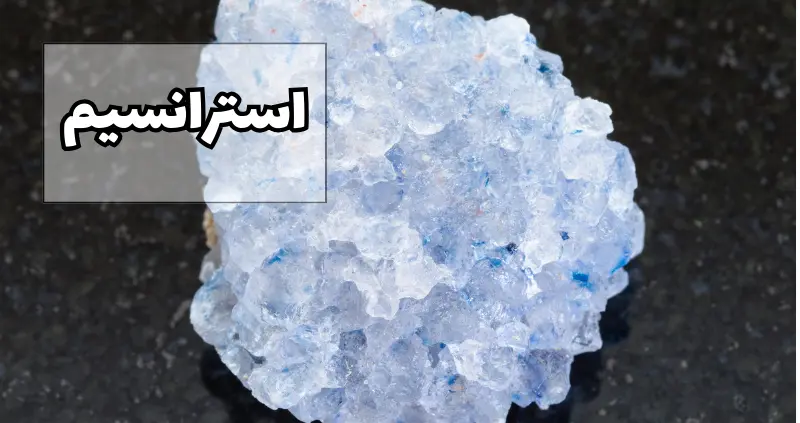
Strontium, a relatively rare and rare element, has been of increasing interest among researchers and industrialists. This alkaline earth metal, with its unique properties and diverse applications, plays an important role in the development of modern technologies. From nuclear technologies to electronics and ceramic industries, strontium is present as a key component. But behind these widespread uses, there is a hidden story of limited resources, challenging extraction and environmental hazards. In this article, we will examine the details of strontium, from its chemical properties to its future applications and prospects, and discover why this rare element is of vital importance to the advancement of technology and industry today.
Definition and properties of strontium
Strontium (Sr) is an alkaline earth metal that is in group 2 of the periodic table of elements. This relatively rare element is found in the earth’s crust and has unique properties. In terms of physical properties, soft strontium is a silvery-white metal that quickly oxidizes and turns yellow when exposed to air. The melting temperature of this metal is 777 degrees Celsius and its boiling temperature is 1384 degrees Celsius. Also, strontium is considered a chemically relatively active alkali metal and reacts quickly when exposed to air, oxygen and water.
In terms of chemical properties, strontium has an electron configuration[Kr] It is 5s^2 and easily loses one or two electrons and turns into a divalent Sr^2+ ion state. This feature makes strontium very active and reactive in chemical compounds. In addition, strontium is found in nature in the form of various compounds such as sulfate, carbonate and nitrate, each of which has unique properties.
The position of strontium in the periodic table of elements is in group 2, which is called the group of alkaline earth metals. This group includes beryllium (Be), magnesium (Mg), calcium (Ca), strontium (Sr), barium (Ba) and radium (Ra). These elements have low electronegativity and relatively large atomic radius. Also, due to having valence electrons in the s layer, these elements are very active and react easily.
Sources and production of strontium
Natural sources of strontium in the earth’s crust are very limited. This element is mainly found in mines Celestine mineral (SrSO4) is found. Celestine occurs naturally in some clay, limestone, and basaltic sediments. Also, strontium is present in barite (BaSO4) and anhydrite (CaSO4) minerals. Compared to other alkaline earth metals such as calcium and barium, strontium resources are much more limited, which limits its production and availability.
The process of strontium extraction and production includes several steps. First, Celestine ore is extracted and crushed. Then, using chemical processes such as dissolving in acid, evaporation and crystallization, strontium is separated into various compounds such as carbonate, nitrate and hydroxide. In the next step, these compounds are converted into metallic strontium using electrolytic and metallurgical processes. Finally, strontium metal is produced and marketed as ingots or sheets.
Due to the scarcity of natural sources of strontium and the complexity of its production processes, this element is considered one of the most expensive metals. In this regard, research on finding new sources, improving extraction and production processes, as well as recycling strontium from industrial waste is being carried out in order to increase access to this valuable material.
Applications of strontium
Due to its unique properties, strontium is used in various fields of industry and technology. One of the most important applications of strontium is in the electronics industry. Strontium compounds, especially strontium nitrate, are used as phosphors in cathode lamps and tube television displays. These compounds cause a red color in the displays. Also, strontium is used in the production of lithium-ion batteries, capacitors and sensors.
Strontium also plays an important role in the nuclear industry. One of its important applications in this industry is the use of the radioactive isotope strontium-90 in the production of nuclear batteries. These batteries are used as a power source in satellites, spacecrafts and medical devices. In addition, strontium isotopes are also used in cancer treatment.
The glass and ceramic industry is another field of application of strontium. Strontium compounds are used as additives in the production of special glasses such as crystalline glass, optical glass and medical glass. Also, strontium plays an important role in the production of special ceramics such as piezoelectric ceramics. These applications are due to the effect of strontium on the optical, electrical and mechanical properties of these materials.
Safety and environment
Strontium and its compounds can be dangerous for the environment and human health. This element is easily dispersed in the environment and can enter the food chain. Research has shown that strontium can replace calcium in the body and cause disturbances in physiological processes. Also, strontium is potentially toxic to living organisms and can cause damage to the skeletal, digestive, and nervous systems.
Therefore, strict safety and environmental measures must be applied in the processes of extraction, production and use of strontium. Workers should not be exposed to the contamination of this element by observing safety measures, including the use of personal protective equipment and conducting regular medical tests. Also, proper management of waste containing strontium and preventing its release in the environment is of great importance.
In this regard, strict laws and regulations have been established at the international level to control and limit the use of strontium. These laws include limits on the amount of pollution allowed in the environment, waste management requirements and how to safely transport this material. Compliance with these laws and continuous monitoring can prevent environmental and health risks caused by strontium.
Know more: Ferosilis base
final word
In today’s technological progress and innovation, strontium plays a prominent role. With its unique properties, this rare element has key applications in various fields from the electronics industry to nuclear energy and ceramics. But behind these amazing achievements lie many challenges – from limited natural resources to environmental hazards. Industries and researchers are constantly searching for innovative solutions to increase the availability of this precious metal and reduce its possible damages. The future of strontium is full of fascinating promises and challenging questions – a future that calls us to explore the mysterious aspects of this rare element.
